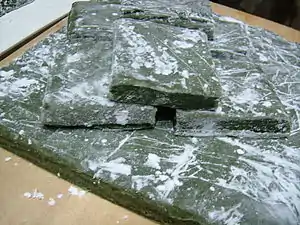Kusa mochi
Kusa mochi (草餅, lit. "herb mochi"), also known as kusamochi or yomogi mochi (蓬餅), is a Japanese sweet. It is made from mochi and leaves of yomogi, also known as Japanese mugwort. Because Japanese mugwort is kneaded into the mochi, kusa mochi takes on a vivid green color. The greenness of it depends on the amount of Japanese mugwort blended in the mochi. It is also beneficial as medicinal food.
 | |
| Alternative names | Yomogi mochi |
|---|---|
| Type | Wagashi |
| Place of origin | Japan |
| Main ingredients | Mochi, yomogi leaf; red bean paste |
| 150 (for 50g) kcal | |
History
_(24368243434).jpg.webp)
The custom to knead Japanese mugwort was transmitted from the Chinese.[1] Documents state that nobles were eating kusa mochi during palace events in the Heian era.[1] It used to be made with Jersey cudweed before the Heian era.[2] However, since the Heian era, people started to make kusa mochi using Japanese mugwort (or yomogi) because of its capability to boost fertility and as medicinal food was discovered.[1] Another purported reason for the change in ingredients was because Jersey cudweed is called Haha-ko-gusa which literally translates to "mother-and-child grass".[3] As kusa mochi was enjoyed with a purpose of wishing for the health and well-being of mother and her children, it was considered ominous to knead jersey cudweed into the mochi.[3]
Since the Edo-era, kusa mochi began to be used as offering for Hinamatsuri (the Girl's Festival).[1] The reason it was chosen as the offering was because of the vivid green color that represents fresh verdure.[1] Another reason why it was chosen as an offering is because of the medicinal power of Japanese mugwort.[4] Japanese mugwort is known for its vitality, which makes it difficult to eradicate.[1] Kusa mochi was used as an offering with a desire of health and longevity.[1]
As medicinal food
.jpg.webp)
The idea of food being fundamentally connected to medication has been present for a long time.[5] The Japanese mugwort, which is the main ingredient of kusa mochi, has a history of at least 2,500 years of medicinal use.[5] In one piece of Japanese ancient literature, it is stated that Japanese mugwort can be used as a hemostatic, a medicine for diarrhea, and for miscarriage prevention, and these uses are still put to practical use today.[5] Japanese mugwort has many active ingredients that are beneficial to the body, such that it is also known as "the queen of herbs".[4] Some of its components are dietary fiber, chlorophyll, vitamin B1 and vitamin B2.[4] Some of its effects are preventing constipation, ameliorating the intestinal environment, and having antioxidant action.[6] Research done in by the Hokkaido Tokachi Area Regional Food Processing Technology Center has claimed that Japanese mugwort is effective in improving blood flow.[6] It is said that it helps expand the blood vessels and thus effective for people with bad circulation.[6]
The Japanese mugwort is a member of the asteraceae plant family, which some people have allergies to.
See also
- Qingtuan, the original Chinese form of this dish, also consumed during the spring
- Caozai guo, the Fujianese form
References
- "草餅の特徴・歴史・味 - 和菓子の季節.com". wagashi-season.com. Retrieved 2020-01-29.
- Ishihara, Masami (2017-03-04). "【和菓子歳時記17】春の季語の1つ「草餅」で、季節の変わり目の厄払い". 家電 Watch (in Japanese). Retrieved 2020-01-29.
- "草餅を食べる由来と時期!美味しい作り方や驚きの栄養効能とは?". shikitari.net (in Japanese). 2019-03-18. Retrieved 2020-01-30.
- "草餅、その美しい緑に「春が来た!」と感じられる和菓子". 美しい日本の和菓子 (in Japanese). 2015-12-04. Retrieved 2020-01-29.
- Chen, Hanxi (2013). "Medicinal Food of "Kusamochi" and its culture in Japan". Ningen Kagaku Kenkyu. 26: 70. hdl:2065/39333.
- Minami, Keiko (2014-03-06). "よもぎ餅からよもぎ蒸しまで! 女性の健康とよもぎ". [食と健康] All About (in Japanese). Retrieved 2020-01-30.